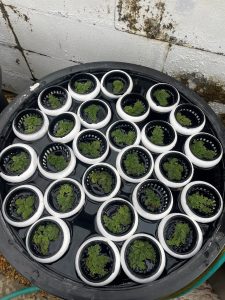This blog post was written by Corrina Vuillequez, Agronomy graduate student with UF/IFAS CAIP and aquatic plant control intern for the U.S. Army Corps of Engineers (ACE).
Our recent blog post discussed preventative measures boaters can take to keep giant salvinia out of Florida’s waters. Since then, a new outbreak of the plant has been identified in Jacksonville, Florida. A population of giant salvinia was found covering an entire retention pond! The pond has a drain leading to a creek, that eventually flows into the St. Johns River. We don’t know where the source population came from, but we know that management agencies are acting as quickly as possible to stamp out this outbreak and prevent it from spreading further.

Giant salvinia (Salvinia molesta), is a floating aquatic fern native to Brazil. It has a unique shape and interesting texture, making it attractive to ornamental gardeners worldwide. Unfortunately, once introduced to the Southern United States it has taken over many lakes and ponds. This plant is known to double in less than 3 days! Not only does it grow outward, but it can also form thick, dense mats across the water’s surface. These mats of giant salvinia can prevent boaters, fishermen, and swimmers from enjoying the water. Giant salvinia has been reported in 13 states and is classified as a Federal Noxious Weed, meaning it is illegal to transport. However, it can be spread unintentionally on boats and trailers.
What is being done about it?
When managing invasive species, using an integrated approach to attack the problem from multiple angles is important. The Jacksonville District is working hard with the City of Jacksonville and the Florida Fish and Wildlife Conservation Commission to address this outbreak. Some physical plant removal has been done, but since giant salvinia can re-grow from any pieces left behind, this method alone isn’t efficient for an outbreak of this scale. The Invasive Species Management Branch of the U.S. ACE Jacksonville District has barriers up to prevent further spread of the invader and also treated the outbreak with herbicides.
Knowing how it can quickly take over an entire pond, the idea of it reaching the St. Johns River is concerning. This raises the question: Can giant salvinia survive in the river? An important piece to this puzzling question is knowing the salinity levels (amount of salt in the water) in the retention pond, creek, and connecting St. Johns River. Giant salvinia is a freshwater plant, and the St. Johns can range from freshwater to brackish to saltwater, depending on the part of the river and tidal influences. Little is known about the salt tolerance of giant salvinia, and that’s where we come in at the UF/IFAS Center for Aquatic and Invasive Plants (CAIP).
There is little known about the salt tolerance of giant salvinia, and that’s where we come in at the UF/IFAS Center for Aquatic and Invasive Plants.
Our study

Here at CAIP, we are designing a study to test this very question. Giant salvinia will be exposed to different concentrations of saltwater for different amounts of time, and then monitored for growth. The exposure time is important, as plants in the St. Johns may only be exposed to increased salinity levels for a few hours at a time due to tidal influences on the river.
In this study, we will have tubs of water with different salinities. To separate the giant salvinia into individual units (replications) to track throughout the study, we had to get creative. As you can see in the picture (right), each replication will have its own mini-pot with a floatie inside the larger tub! Each mini-pot will have a label on its floatie, indicating the time interval at which it will be removed from the salt treatment and placed into fresh water.
This study is set to take place in February, and the results will be used to inform the Jacksonville district about what they’re up against. Maybe giant salvinia can’t survive in the St. John’s at all! But we won’t know for sure until we have more data. Stay tuned as we turn science into solutions.
This blog post was written by Corrina Vuillequez, Agronomy graduate student with UF/IFAS CAIP and aquatic plant control intern for the U.S. Army Corps of Engineers (ACE). Questions or comments can be sent to the UF/IFAS CAIP communications manager at caip@ifas.ufl.edu. Follow UF/IFAS CAIP on Instagram. Subscribe for more blogs like this one.
UF/IFAS Center for Aquatic and Invasive Plants. Turning Science Into Solutions.
Did you find this post helpful? Click the heart below!
 7
7
